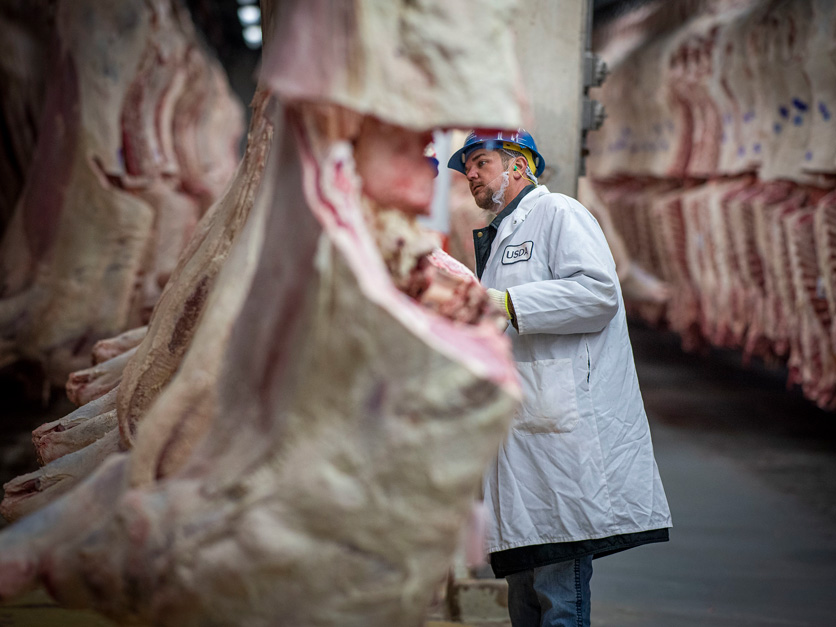Shuttered restaurants and displaced food service workers are among the many enduring images of the economic impacts of the COVID-19 pandemic. Many of those dining establishments were used to serving some of the finest beef American producers could offer, leaving consumers with the option of preparing the high quality protein in their own homes.
Now, many of those consumers show no signs of stopping.
Three years since the massive economic shifts of March 2020, many previous economic patterns are back to normal, including eating a juicy USDA Prime steak at a white tablecloth restaurant. But shoppers' move toward preparing higher quality wasn’t a short-lived shopping experiment.
“We taught our consumer what better product was, and they love it,” Kevin Good, vice president of industry relations at CattleFax, said in an interview with Agri-Pulse. The COVID-19 pandemic, he added, “expanded the customer base for prime and top two-thirds choice. The (price) spreads reflect that in 2022, and we think they’ll reflect that again in 2023.”
 Don Close, TerrainThe combination of the availability of higher quality product — USDA Prime rather than choice or select — and a rush to purchase fancy backyard grills and smokers — “man croc pots,” as industry analyst Don Close dubbed them — had shoppers less worried about the price tag on steaks and briskets in the early days of the pandemic. Many workers shifted to teleworking, offering them more time to monitor a delicate cooking process, and more seasoned home chefs started experimenting with pricier cuts of meat.
Don Close, TerrainThe combination of the availability of higher quality product — USDA Prime rather than choice or select — and a rush to purchase fancy backyard grills and smokers — “man croc pots,” as industry analyst Don Close dubbed them — had shoppers less worried about the price tag on steaks and briskets in the early days of the pandemic. Many workers shifted to teleworking, offering them more time to monitor a delicate cooking process, and more seasoned home chefs started experimenting with pricier cuts of meat.Close, the chief research and analytics officer for Terrain, said producers were prepared for the change.
“Not only did we shift that availability of prime product from traditional white tablecloth restaurants to retail,” he said, the nation’s producers “had finally increased” the typical percentage of the nation’s beef cattle grading either as prime or in the upper two-thirds of choice “to create an economy of scale where packers and suppliers had a quantity to supply grocery stores.”
But for producers to keep enough prime beef on the table — whether that table comes with a wine list or is surrounded by patio chairs — some recent slaughter patterns might have to shift.
Lance Zimmerman, a beef industry analyst for Rabobank, said the reduced capacity brought about by plant shutdowns during the peak of the virus’ spread caused more cattle to be put on hold and spend more time in the nation’s feedlots and along other stops in the beef supply chain. Once that backlog cleared, a drought forced many producers to send younger cattle for processing due to a lack of viable feed.
“All else equal, you reduce the days of age of cattle, you reduce quality grade, and so even amid record high beef production last year, we actually saw the percent of prime, percent of upper two-thirds choice pull back just a little bit because of that,” Zimmerman said.
Now, he added, Millennial shoppers — the largest demographic in the supermarket aisles — “are eating the highest-quality beef they’ve ever had in their lifetime.”
A recent report underscores the boost in demand across multiple meat categories including beef.
Fresh meat remains a staple in consumers’ grocery carts despite rising food and beverage costs, according to the 18th annual Power of Meat report released Monday by the North American Meat Institute and FMI-The Food Industry Association.
In fact, the report said, Americans are buying more fresh meat than before the pandemic.
Meat department prices rose 9.3% in 2022, below the 12.4% increase for all food and beverages. Although those prices helped lead to a 2.5% drop in purchase volume compared to 2021, shoppers spent more than $15 in the meat department per trip and averaged nearly one trip to the meat department per week.
Don’t miss a beat! It’s easy to sign up for a FREE month of Agri-Pulse news! For the latest on what’s happening in Washington, D.C. and around the country in agriculture, just click here.
The demand for higher-quality product by its nature has been insulated from price shocks; cheaper alternatives were always available but consumers opted for nicer cuts for a variety of reasons.
But with the industry headed into the contraction phase of the cattle cycle and drops in production expected, tighter supplies could also push the prime price to untested levels. CattleFax projects beef retail prices will increase about 1% this year — less than inflation in other parts of the economy due to price increases already levied in recent years.
“Let’s remember, supplies are going to get pretty doggone tight; they’re going to get tighter than they’ve been even at the last cycle low on a per capita basis,” Good said. “We also like where we’re positioned from a prime and top two-thirds choice demand standpoint. That demand is not influenced nearly as much by disposable income.”
Close concurs to a degree, noting some kind of market impact for higher quality cuts wouldn’t necessarily be immune to a potential recession or some other shock to consumer pocketbooks. But he said he thinks the initial taste of the product — and two years to get used to it — has “set the road map as we talk longer-term and beyond (a) recession. I think that satisfaction with that eating experience ...is going to hold.”
Jacqui Fatka contributed to this story.
For more news, go to www.Agri-Pulse.com.


